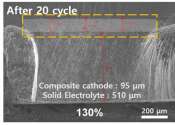Hyperion launches futuristic hydrogen-fueled car
Carroll Shelby, who designed the classic Shelby Mustang in the sixties, once quipped: "I've always been asked, 'What is my favorite car?' and I've always said, 'The next one.'"
Energy & Green Tech

Carroll Shelby, who designed the classic Shelby Mustang in the sixties, once quipped: "I've always been asked, 'What is my favorite car?' and I've always said, 'The next one.'"
Engineering

Often referred to as the "dream batteries," all-solid-state batteries are the next generation of batteries that many battery manufacturers are competing to bring to market. Unlike lithium-ion batteries, which use a liquid ...
Dec 4, 2023
0
108
Energy & Green Tech

Scientists of the National University of Science and Technology "MISIS" (NUST MISIS), part of an international team of researchers, managed to increase the capacity and extend the service life of lithium-ion batteries. According ...
Mar 10, 2021
0
228
Engineering

Researchers in the Cockrell School of Engineering at The University of Texas at Austin have built a new type of battery that combines the many benefits of existing options while eliminating their key shortcomings and saving ...
Jul 7, 2020
4
124
Energy & Green Tech

Battery-breakthrough stories continue with expectations that in time we will finally get some answers—that some innovator confronting issues of traditional lithium ion batteries will figure out an economy of manufacture ...
Energy & Green Tech

Researchers at WMG at the University of Warwick have found that use of inductive charging, whilst highly convenient, risks depleting the life of mobile phones using typical LIBs (Lithium-ion batteries)
Jun 26, 2019
0
2
Energy & Green Tech

In recent years, engineers worldwide have been trying to devise new battery and energy storage technologies that are more sustainable and cost-effective. One of the solutions attracting particular interest is sodium-based ...
Energy & Green Tech

Amionx, the California company has won headlines for its explosion-free battery technology; the company expects to license its advance for use in commercial products by the end of 2019.
Electronics & Semiconductors

Rechargeable batteries are at the heart of many new technologies involving, for example, the increased use of renewable energies. More specifically, they are employed to power electric vehicles, cell phones, and laptops. ...
May 7, 2020
0
256
Energy & Green Tech

An MIT spinout is preparing to commercialize a novel rechargable lithium metal battery that offers double the energy capacity of the lithium ion batteries that power many of today's consumer electronics.
Aug 17, 2016
0
2469
An ion is an atom or molecule where the total number of electrons is not equal to the total number of protons, giving it a net positive or negative electrical charge.
Since protons are positively charged and electrons are negatively charged, if there are more electrons than protons, the atom or molecule will be negatively charged. This is called an anion (pronounced /ˈænaɪən/; an-eye-on), from the Greek ἀνά (ana), meaning 'up'.
Conversely, if there are more protons than electrons, the atom or molecule will be positively charged. This is called a cation (pronounced /ˈkætaɪən/; cat-eye-on), from the Greek κατά (kata), meaning 'down'.
An ion consisting of a single atom is called a monatomic ion. If it consists of two or more atoms, it is called a polyatomic ion. Polyatomic ions containing oxygen, such as carbonate and sulfate, are called oxyanions.
When writing the chemical formula for an ion, its charge is written as a superscript '+' or '−' following a number indicating the difference between the number of protons and the number of electrons. The number is omitted if it is equal to 1. For example, the sodium cation is written as Na+, the '+' indicating that it has one less electron than it has protons. The sulfate anion is written as SO42−, the '2−' indicating that it has two more electrons than it has protons.
If an ion contains unpaired electrons, it is called a radical ion. Just like neutral radicals, radical ions are very reactive.
This text uses material from Wikipedia, licensed under CC BY-SA